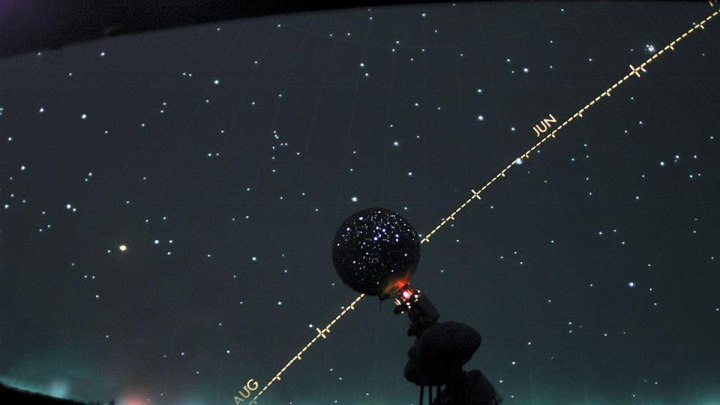Celebrating 50 Years of Exploring the Universe
Seeing Beyond the Stars
As the VCSU Planetarium celebrates the facility’s 50th anniversary, faculty, staff and students reflect on how the unique space has changed their perspective and equipped them to explore and understand the world.
Tucked up on the third floor of the L.D. Rhoades Science Center is the only place in North Dakota to see the stars clearly in December in 70 degree temperatures.
This fall the VCSU Planetarium celebrated 50 years in operation. This unique part of campus was created after $1 million was invested in building a new Science and Mathematics building. $62,000 of that cost was designated for a state-of-the-art Spitz Laboratories planetarium system.
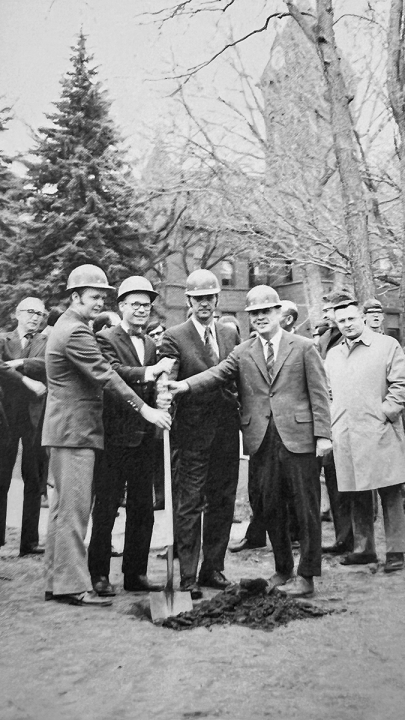
In 1972 and 1973, the dream began to take shape. The third floor classrooms were finished. Workers assembled a 500 pound aluminum tubing into a dome frame and lined it with vinyl. It was placed as the ceiling in a classroom. Below the dome, a unique mechanical structure with a hole-filled sphere on one end was mounted in the center of the room. With the lights off, the room became a small, vivid version of the night sky.
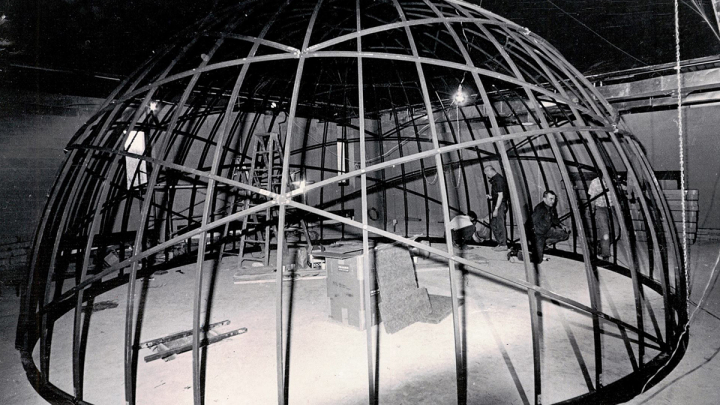
The classroom was to be used to teach astronomy, but also incorporate other disciplines including literature, music, social studies, math, and drama, Chair of the Math and Science Department in 1973 Dr. Charles Walker said at the time. In an article in the Times Record, he voiced his hope that the space would be used for “teaching and learning in many vocations,” and for the community.
Dreams became a reality and the planetarium has been the vehicle audiences have used to walk through the universe, 50 people at a time.
Guided by Starr
Wes Anderson ’97 was a first year student 20 years after the planetarium was built.
As a history major, he wasn’t sure what he wanted to do with his life. His advisor signed him up for an astronomy class with Joe Stickler. He found the intersection of the stars, the way they shaped history, and the impact on society fascinating. His interest led him to Eileen Starr.
Starr had recently created a unique planetarium class that focused on students using their skills to write and produce shows and then show them using the planetarium. She wanted students to learn how to use the equipment.
“She encouraged my interest in this stuff,” Anderson said of Starr. “She needed someone local to run the place when she was gone, so she took me under her wing.” Anderson laughed as he explained how he was part of Starr’s “master plan.” Anderson loved continuing to learn about the history of civilizations and their relation to the stars, but he also loved working with the actual machine. “I like all kinds of old technology,” Anderson said.
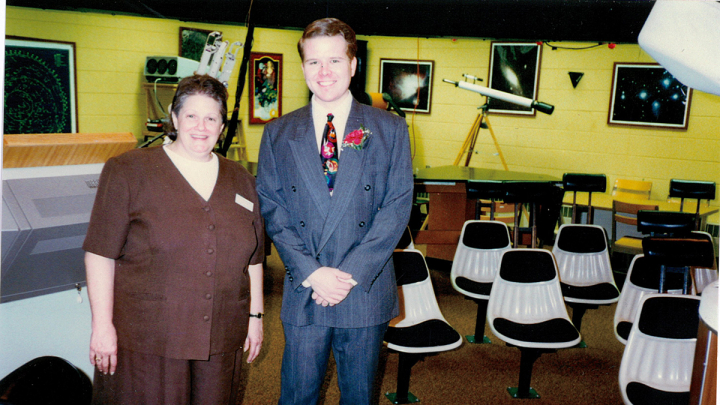
Anderson graduated and continued to help with shows and keeping the machinery running smoothly. When Starr retired in 2002, Anderson became the next director. This fall, he welcomed students, friends, faculty, alumni and the community back to the space to celebrate the 50th anniversary. Throughout his life, he has been a member of all of those groups.
“I have made a lot of very good friends here and we have had a lot of fun up here,” he said. “Sitting in the planetarium and looking at the stars is pretty cool.”
Crafting shows through collaboration
One of those friends is Brenda Jarski-Weber, ’06. Originally from Wimbledon, Jarski-Weber began her studies in Bottineau but developed an interest in taking a Mycology class. She discussed taking that class with Dr. Hilde van Gijssel and “next thing I knew I was signed up for classes and getting ready for a botany field trip.”
She needed one more credit to be full time and that led her to the Planetarium Science course.
“I always loved being a part of the planetarium,” she said. “Putting on shows was always fun, especially when kids were in the planetarium for the first time.” Hearing students exclaim as the lights went down and the stars came out was “very satisfying and entertaining.”
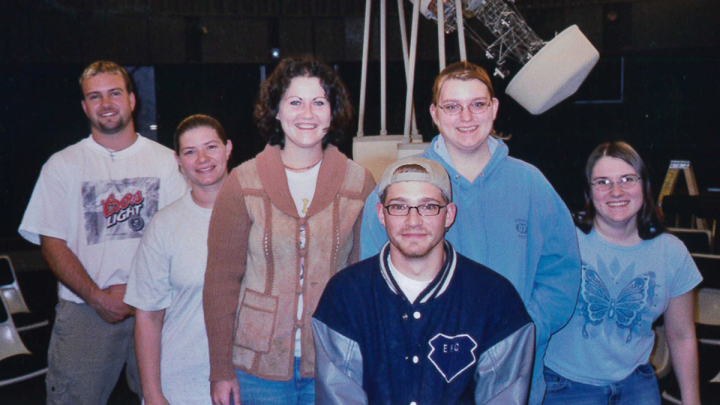
She collaborated with other students for months to develop and premiere the show Native American Night.
“I was so satisfied to see months of work come to completion,” Jarski-Weber said. Part of that satisfaction was the fact that it required close collaboration with others.
“I worked as a wildlife field biologist for many years and generally worked alone,” she explained. “Being a part of the Planetarium was a great lesson in working on give and take and compromise.”
Working with a team was also something Burke Tagney ’13 enjoyed as a student in Planetarium Science. Tagney has been using skills he learned in Anderson’s class throughout his career, including in his current position as the IT Coordinator for Midwest Financial Partners. He originally came to VCSU from Montana to play baseball and study business. His path led him to add a theater minor and that connection landed him in the planetarium. Tagney helped produce a show and eventually began spending free time working with Anderson on the shows and productions. Tagney took Planetarium Science for two years.
“We were working on the show Finding Polaris, technically Finding Polaris II,” he said. The group wrote the show together and used equipment in the music department to record the audio files. “It was maybe a little more of an entertaining show. “That was my first experience and it ended up being an absolute blast.”
Tagney said that developing the show was one of his only experiences doing voice over work, something which he thoroughly enjoyed. He also enjoyed getting to work with the Spitz system that powers the star display.
The technology in the planetarium was state-of-the-art when it was installed 50 years ago. The machine is virtually unchanged to this day through the maintenance skills of people like Anderson and students he teaches. Although the planetarium now uses PowerPoint instead of actual slide decks, much is unchanged. The machine brings analog lights to life in a digital world.
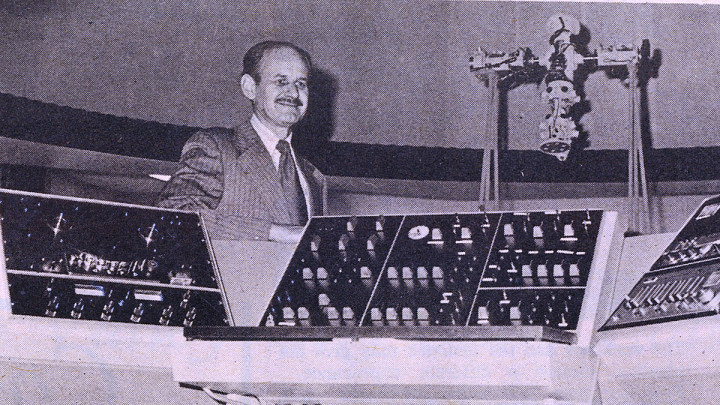
“I think this gave me a good taste of the real world,” he explained. “I love some of that older technology. There is a nostalgia factor, but also, some things just work. I work in technology now and sometimes there are so many hands in the cookie jar that may think they know what is better and want to redesign everything. But here is this piece of equipment that was ridiculously expensive at the time and I think the idea is that we can keep this thing going. It does what it was designed to do and does it really well.”
“It’s not at a point where it is taking away from the experience, but it is the experience,” Tagney said. “There is something about having this big, physical machine right in the middle of the room. Then it goes dark and boom, it’s projecting everything from that machine. It becomes more of a character itself.”
Seeing the other side of the world
This fall, students Clayton Bleick, Syd Schmidt and Jasmine Barnes have continued the work of Tagney, Jarski-Weber and dozens of students who came before. The trio have been working to finish one of the shows that an earlier class started, but didn’t have time to complete production.
“Currently we are writing scripts. Then we are planning to record them and edit the audio,” Bleick, of New Salem, explained. As an audio production major, Bleick and his classmates show how Planetarium Science course continues to be a place where music, science and creativity intersect.
Bleick’s favorite part of the course has been getting to use the Planetarium and understand how it works.
“It’s very accurate and you can turn it on and see what it looks like on the other side of the world,” he said. “It’s fascinating to think about this is what it would look like if I was in Australia, or the Arctic.”
Classmate Jasmine Barnes of Redwood Falls, MN, is no stranger to the science building. As a Health Science major with two minors in psychology and chemistry, her class load has been heavy and challenging. Working in the Planetarium Science class has brought a different kind of fun to her fall schedule. She enjoys the hands-on nature of the course work and how Anderson has encouraged them to take their time crafting a good show.
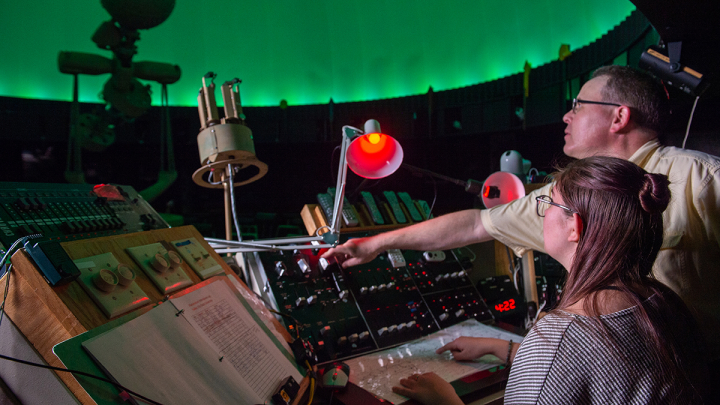
Barnes said stopping by the planetarium for a weekend show is a great way to get a perspective about earth and the things that really matter.
“I think even if you are not interested in the stars, it is neat to see the machinery,” she said. “It’s cool to see that our school has something unique like this.”
Skills for Life
Not only is the facility unique, the class Planetarium Science is a one-of-a-kind, according to Anderson. When Starr created the class in 1992, as far as Anderson can tell, it is the only class where students learn how to operate the machine.
Saralynn Dobler was of those students that learned how to operate the Spitz machine. Dobler came back to campus for the 50th anniversary last summer to see a planetarium show and catch up with Anderson.
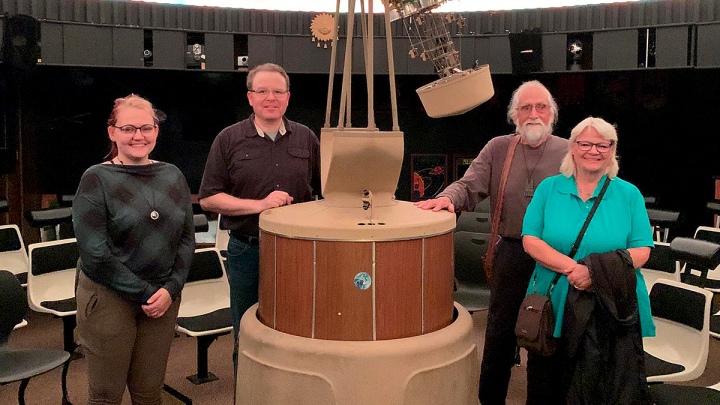
Dobler was always interested in the stars, even before her parents got her a telescope for her 10th birthday. She jumped right into the planetarium course her first year at VCSU and enjoyed creating and presenting shows. She helped craft a show about the solar system. Dobler eventually transferred to the only other nearby school with a planetarium and started working at that facility as well.
Now, as a graphic designer, Dobler said the things she learned at the planetarium have helped her in her career and life.
“Talking about something that I love gave me the confidence to speak in front of an audience. Designing shows and understanding what people liked helped me become a better graphic designer,” she said. In addition, the planetarium offers a perspective that helps expand perspectives. “There’s nothing else like a planetarium, You always learn something new, even if you have seen the show 100 times like I have. I think introducing kids to space is important.”
